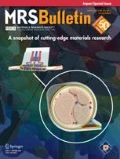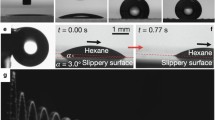Abstract
Recent experiments have revealed that the wax on the lotus leaf surface, by itself, is weakly hydrophilic, even though the lotus leaf is known to be superhydrophobic. Conventional understanding suggests that a surface of such waxy composition should not be able to support superhydrophobicity and high contact angles between a liquid and the surface. Here, we show that the unexpected superhydrophobicity is related to the presence of “reentrant texture” (that is, a multivalued surface topography) on the surface of the lotus leaf. We exploit this understanding to enable the development of superoleophobic surfaces (i.e., surfaces that repel extremely low-surface-tension liquids, such as various alkanes), where essentially no naturally oleophobic materials exist. We also develop general design parameters that enable the evaluation of the robustness of the composite interface on a particular surface. Based on these design parameters, we also rank various superhydrophobic and superoleophobic substrates discussed in the literature, with particular emphasis on surfaces developed from inherently hydrophilic or oleophilic materials.
Similar content being viewed by others
References
Y. Yu, Z.H. Zhao, Q.S. Zheng, Langmuir 23 (15), 8212 (2007).
M. Callies, D. Quéré, Soft Mater. 1 (1), 55 (2005).
L. Cao, H.H. Hu, D. Gao, Langmuir 23 (8), 4310 (2007).
A. Otten, S. Herminghaus, Langmuir 20 (6), 2405 (2004).
W. Chen, A.Y. Fadeev, M.C. Hsieh, D. Oner, J. Youngblood, T.J. McCarthy, Langmuir 15 (10), 3395 (1999).
A. Tuteja, W. Choi, M.L. Ma, J.M. Mabry, S.A. Mazzella, G.C. Rutledge, G.H. McKinley, R.E. Cohen, Science 318 (5856), 1618 (2007).
W.A. Zisman, Relation of the equilibrium contact angle to liquid and solid construction. In Contact Angle, Wettability and Adhesion, ACS Advances in Chemistry Series (American Chemical Society: Washington, DC, 1964), vol. 43, pp. 1–51.
K. Tsujii, T. Yamamoto, T. Onda, S. Shibuichi, Angew. Chem., Int. Ed. Engl. 36 (9), 1011 (1997).
S. Shibuichi, T. Yamamoto, T. Onda, K. Tsujii, J. Colloid Interface Sci. 208 (1), 287 (1998).
A. Ahuja, J.A. Taylor, V. Lifton, A.A. Sidorenko, T.R. Salamon, E.J. Lobaton, P. Kolodner, T.N. Krupenkin, Langmuir 24 (1), 9 (2008).
S.R. Coulson, I.S. Woodward, J.P.S. Badyal, S.A. Brewer, C. Willis, Chem. Mater. 12 (7), 2031 (2000).
S. Herminghaus, Europhys. Lett. 52 (2), 165 (2000).
N.J. Shirtcliffe, G. McHale, M.I. Newton, C.C. Perry, B.F. Pyatt, Appl. Phys. Lett. 89 (10), 104106 (2006).
L. Zhai, F.C. Cebeci, R.E. Cohen, M.F. Rubner, Nano Lett. 4 (7), 1349 (2004).
The submerged superhydrophobic surface acts like a mirror because of the total internal reflection of light caused by the entrainment of the thin layer of air between the superhydrophobic surface and water.
L. Zhai, M.C. Berg, F.C. Cebeci, Y. Kim, J.M. Milwid, M.F. Rubner, R.E. Cohen, Nano Lett. 6 (6), 1213 (2006).
F.C. Cebeci, Z. Wu, L. Zhai, R.E. Cohen, M.F. Rubner, Langmuir 22 (6), 2856 (2006).
R.N. Wenzel, Ind. Eng. Chem. 28, 988 (1936).
A.B.D. Cassie, S. Baxter, Trans. Faraday Soc. 40, 546 (1944).
A. Marmur, Langmuir 19 (20), 8343 (2003).
M. Nosonovsky, Langmuir 23 (6), 3157 (2007).
R.E. Johnson, R.H. Dettre, Contact angle hysteresis. In Contact Angle, Wettability and Adhesion, ACS Advances in Chemistry Series (American Chemical Society: Washington, DC, 1964), vol. 43, pp. 112–135.
N.A. Patankar, Langmuir 19 (4), 1249 (2003).
A. Lafuma, D. Quéré, Nat. Mater. 2 (7), 457 (2003).
B. He, N.A. Patankar, J. Lee, Langmuir 19 (12), 4999 (2003).
L. Barbieri, E. Wagner, P. Hoffmann, Langmuir 23 (4), 1723 (2007).
J. Bico, U. Thiele, D. Quéré, Colloid Surf. A 206, 41 (2002).
Y.-T. Cheng, D.E. Rodak, Appl. Phys. Lett. 86 (14), 144101 (2005).
J.-L. Liu, X.-Q. Feng, G. Wang, S.-W. Yu, J. Phys.: Condens. Matter 19 (35), 356002 (2007).
C.W. Extrand, Langmuir 18 (21), 7991 (2002).
D.H. Reneker, A.L. Yarin, H. Fong, S. Koombhongse, J. Appl. Phys. 87 (9), 4531 (2000).
M. Ma, R.M. Hill, J.L. Lowery, S.V. Fridrikh, G.C. Rutledge, Langmuir 21 (12), 5549 (2005).
M. Ma, M. Gupta, Z. Li, L. Zhai, K.K. Gleason, R.E. Cohen, M.F. Rubner, G.C. Rutledge, Adv. Mater. 19 (2), 255 (2007).
T.N. Krupenkin, J.A. Taylor, E.N. Wang, P. Kolodner, M. Hodes, T.R. Salamon, Langmuir 23 (18), 9128 (2007).
Rights and permissions
About this article
Cite this article
Tuteja, A., Choi, W., McKinley, G.H. et al. Design Parameters for Superhydrophobicity and Superoleophobicity. MRS Bulletin 33, 752–758 (2008). https://doi.org/10.1557/mrs2008.161
Published:
Issue Date:
DOI: https://doi.org/10.1557/mrs2008.161




